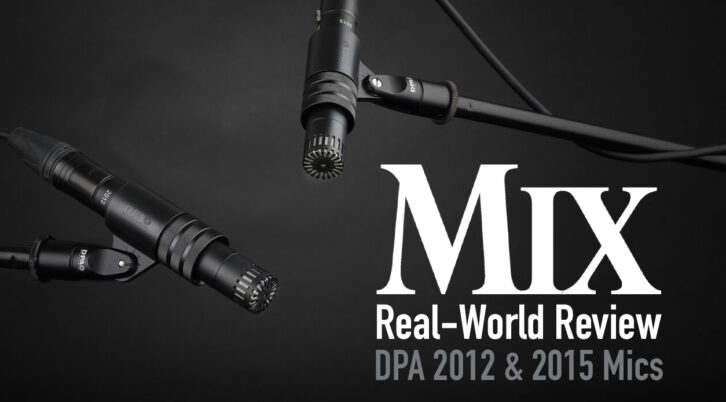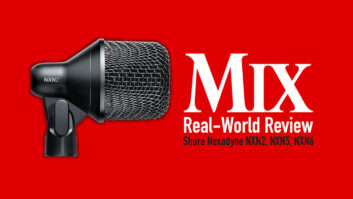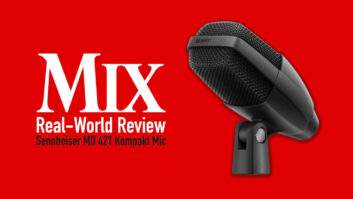
| MIX VERDICT: DPA 2012 COMPACT CARDIOID AND 2015 WIDE CARDIOID |
| THE TAKEAWAY: “You’d be hard-pressed to go wrong with either mic, but I feel like the 2015 offers more versatility.” |
| COMPANY: DPA Microphones • www.dpamicrophones.com PRICE: $849 each; $1595/stereo pair PROS: • Excellent sound quality. • Low noise floor. • Easy to place in tight spaces. CONS: • No HPF or pad switches. |
Designed specifically with live applications in mind, the 2012 and 2015 from DPA are the latest additions to the company’s 2000 Series of microphones. Intended for use on a variety of instruments, the 2012 and 2015 are small-diaphragm mics utilizing 17mm, pre-polarized, pressure-gradient capsules built into a very compact (.75 x 3.7 inches) housing. For situations where a traditional cardioid pattern is too tight (like overhead on a large drum set), the wide-cardioid pattern of the 2015 is recommended.
Specs for the 2012 include sensitivity 8 mV/Pa, -42 dB re. 1 V/ Pa; equivalent noise level 20 dBA typical, maximum SPL 153 dB (@10% THD), and dynamic range 131 dB. Specs for the 2015 include sensitivity 12 mV/Pa, -37.7 dB re. 1 V/Pa; equivalent noise level 18 dBA typical, maximum SPL 150 dB (@10% THD), and dynamic range 132 dB.
Both models have an effective frequency range of 40 Hz to 20 kHz (±2 dB at 11.8 inches), and current consumption is 0.7 mA, well within the 2 mA phantom power spec. Stereo pairs are shipped in a softshell case with compartments for the microphones, mic clips and windscreens, while singles are furnished with a padded zippered pouch, windscreen and clip.
There’s not much to explain about the 2012 and 2015 due to the absence of adjustments or contouring switches, and the mics easily and securely mount in the provided clip: loosen the rotating collar, insert the mic, then tighten the collar to lock the mic into position. It’s a simple yet effective design that allows plenty of flexibility in mic placement, making it easy for me to sneak the 2012s and 2015s into place on toms while avoiding nearby cymbals.
SETTING THEM UP
I used the 2012s and 2015s in a variety of situations on stage and in the studio. During the first outing, I placed the 2012s close-up on toms, and used the 2015s in a spaced-pair configuration for overheads on a drum kit.
The 2012s did a great job rejecting nearby cymbals, even when the ride cymbal was in close proximity. Timbre of the 2012s on toms was full and round, with a bit more bottom end than I care for (a gentle HPF might have come in handy here), but better to have that bottom end and be able to dial it back with a touch of EQ than for the mic to not capture it (I’d later learn that this was in part due to the 2012’s proximity effect). The 2012 captured a lot of detail in the tom sound, clearly reproducing both stick on head and the pitch bend “dooooom” of the decay.
Meanwhile, the 2015s that were overhead (about five feet high, five feet apart, pointing straight down) captured cymbals with a natural smoothness that I’ve come to expect from DPA, while providing consistent coverage from one side of the kit to the other. The 2015s added a nice smack to the toms that complemented the mondo low end of the 2012s, and brought presence to the snare drum. One of the things I like about using the wide cardioid pattern for overheads is that you can place them lower in height without getting “hotspots,” and moving a mic closer to the source always helps reduce leakage from other instruments on the stage.
Swapping positions of the mics (2012s overhead, and 2015s close on toms) produced interesting results. The 2015s allowed more leakage from cymbals (though still an acceptable amount) and didn’t exhibit as much proximity effect as the 2012s. As a result, I preferred the 2015s close-up on toms to the 2012s. The 2012s overhead (spaced pair about six feet high, five feet apart) produced more presence from the snare drum than the 2015s, but the difference was subtle. They also, expectedly, captured less of the room sound.
Back in the studio, I was able to do an A/B comparison of the 2012 and 2015, with one of each used as a mono overhead on a drum kit placed six feet high, directly above the snare and pointing straight down.
The 2015 provided the illusion of being brighter on hat and cymbals, but I feel like this perception can be attributed to the fact that the 2015’s wide cardioid pattern maintains the HF response further off-axis. At 60 degrees off-axis, for example, response of the 2015 at 4 kHz falls to around -7 dB, while that of the 2012 is closer to -10 dB—which also explains the 2015’s ability to capture more room tone given the same placement as the 2012. As I anticipated, the 2012 sounded a bit more “tight” than the 2015, and the 2015 captured a tad more in the bottom end. Either microphone, whether mono or paired, yielded a realistic balance of the kit and would be appreciated by engineers who like to mix the kit from the top down (i.e., starting with the overheads).
ON INSTRUMENTS
Recording a Yamaha upright piano gave me the chance to stage a “shootout” of the 2012 and 2015 with pairs of AKG C414s and Neumann KM184s. The front panel was removed from the piano, and the mics were set as closely together as possible in an “over the shoulder” placement— low mics approximately a foot and a half from the hammers where the low and mid strings meet, and high mics approximately the same distance from the hammers, two-thirds of the way up the keyboard.
The 414s produced a nice attack but too much bottom end for my taste. The KM184s were a bit lean compared to the other pairs but had the edge in clarity. The 2012s and 2015s sounded fuller than the KM184s, with the 2015s delivering a slightly subdued attack compared to the 2012s. To me, the 2015s were the most balanced, probably due to the wideness of the pattern, which enabled the mics to cover the span of the instrument.
Using the 2012 on snare drum showed off its ability to reject unwanted sounds. Leakage from toms and hi-hat was very much attenuated, and stage ambiance was practically non-existent. The compact size of the 2012 made it easy to place, even when the drummer had the ’hat fairly close to the snare drum. The 2012 produced a lot of energy around 200 Hz (which I didn’t love), but a few dB cut around 200 Hz and a slight bump at 5 kHz gave the drum more presence in the mix.
Used to record acoustic guitar in both stereo and mono, the 2015 and 2012 delivered big time. I first tried pairs of both mics placed in NOS stereo roughly two feet in front of the instrument, and the results were fantastic: very realistic, smooth in the top end and consistent from lows to highs, with a really nice sense of the strumming (preamps were an Audient evo SP8, review forthcoming). The 2015 had a layer of sheen and openness that the 2012 lacked, but when the player started to fingerpick, I preferred the slightly laid-back upper-mids of the 2012.
Audio-Technica ATH-M50xSTS StreamSet — A Mix Real-World Review
Switching from stereo pairs to a single mic on the same guitar—placed roughly 10 inches away and pointing toward where the neck meets the body—produced equally beautiful results from either microphone. The 2012 was a bit tighter spatially, and also in terms of frequency extremes, but quite frankly, you can’t go wrong with either microphone.
Definition was impressive when I used either microphone on bar chimes: They were able to capture the individual “ting” of each bar, as opposed to mushing them all together. In this situation, the mics sounded very much alike.
In general, I found that the 2012 had a more pronounced proximity effect, while the 2015 allowed me to get closer to the source without worrying that proximity effect would become an issue—a trait that also seemed to make the 2015 less sensitive to wind noise when used without the wind screen.
DPA has a couple of winners on its hands with the 2012 and 2015. You’d be hard-pressed to go wrong with either mic, but I feel like the 2015 offers more versatility, as long as you’re okay with the idea that they’ll capture more room tone in applications where the mics will be backed off the instrument. Typical of products from DPA, build quality is first-rate.
If I were shopping for mics in this price range, I’d make it a point to audition the 2012 and 2015, but beware—you may end up buying them!







